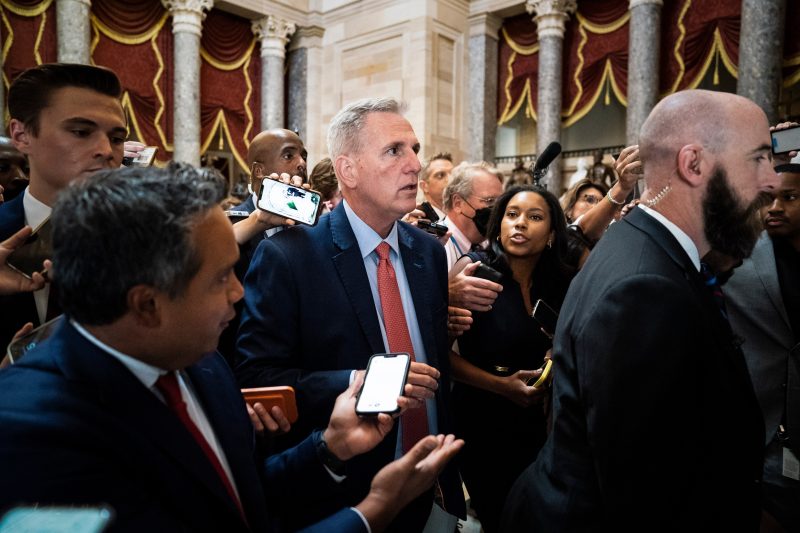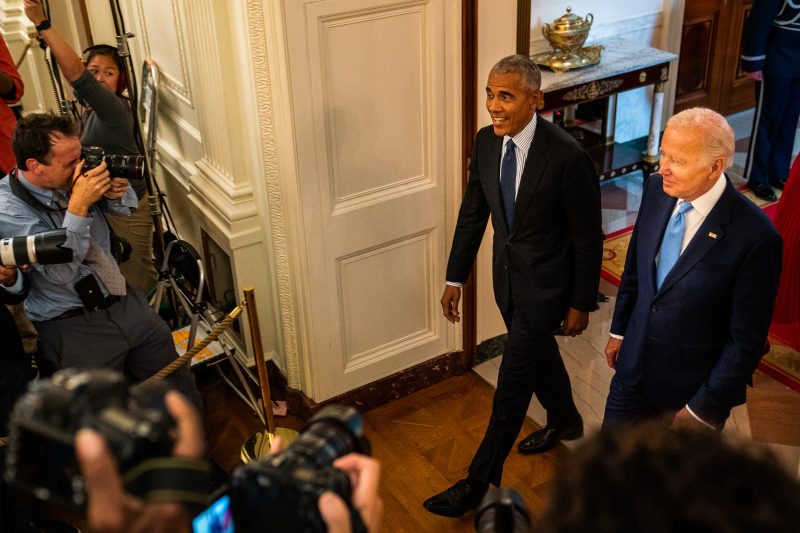Speaker McCarthy steps into the breach as his conference toils

After a drawn-out fight to attain the speakership in early January, lawmakers predicted that the September funding battle would be the real test of House Speaker Kevin McCarthy’s staying power.
That test is here.
With less than two weeks to avoid a government shutdown, McCarthy (R-Calif.) is staring down an open revolt among the hard-right in his conference, some who are threatening to remove him from power and throw the House into further turmoil ahead of a pivotal election year. And across the Capitol, most Senate Republicans have joined hands with Democrats in calls for higher spending levels — as the speaker originally agreed to in the spring — and also want tens of billions of dollars in additional defense spending that is opposed by the House’s hard-right faction.
How McCarthy handles the next two weeks will dictate whether the California Republican can effectively unite his disparate conference and lead them into what will be bruising budget negotiations with the Senate, or whether the loudest voices from a small pocket of rabble-rousers can effectively rule by fiat.
“I don’t walk away from a battle,” McCarthy told reporters Thursday, after lacing into his detractors in an expletive-laden outburst during a closed-door conference meeting. “I knew change in Washington would not be easy. I knew people would fight or try to hold leverage for other things. I’m going to continue to just focus on what’s the right thing to do for the American people, and you know what, if it takes a fight, I’ll have a fight.”
When the House returns Monday evening, they will have seven working days to agree to a short-term funding agreement, pass it and possibly negotiate a compromise with their Senate counterparts before the government runs out of funding on Sept. 30. And right in the middle is McCarthy, who thus far has not been able to find consensus in his conference.
“I think Speaker McCarthy has a path to choose,” said Rep. Bob Good (Va.), one of the hard-line Republicans who opposed McCarthy on the first 14 ballots for speaker in January. “Does he pass Republican legislation that advances our policies and cuts spending with Republican majority, Republican votes, or does he pass legislation with Democrat votes that lets down the American people?”
His close allies think McCarthy, known for his personal touch without very firm red lines on policy matters, has the right mix to thread this treacherous gantlet.
“Nobody has a better sense of where members are at,” said Rep. Dusty Johnson (R-S.D.), who leads a group of more pragmatic Republicans allied with McCarthy. “And I think nobody better understands the contours of what is possible in any given negotiation.”
McCarthy’s first step next week will be to find some way to avert a shutdown, which would start Oct. 1 if Congress cannot pass a stopgap bill that would allow federal agencies to keep operating at last year’s budget levels. That is usually a perfunctory task in most Congresses, but not much comes easy for this particular House speaker. The details of a possible short-term funding plan and how the process would work were detailed to The Washington Post by several lawmakers and aides familiar with the discussions, who spoke on the condition of anonymity to detail private conversations.
McCarthy has tried to find enough support for a stopgap bill, known as a continuing resolution, that maintains current funding levels but would include some sharply conservative policy riders. The most likely offering to hard-liners would be to attach the House GOP’s border security legislation — minus a divisive policy on E-Verify work requirements — that placed strict restrictions for asylum seekers on the southwest border, and possibly attach up to $16 billion in aid to help recovery from recent natural disasters. That aid has bipartisan support in the Senate, but the border legislation does not.
Every Democrat opposed the border bill when it passed the House earlier this year, so McCarthy and other GOP leaders know they will get votes only from their side of the aisle on a stopgap bill with that provision attached. McCarthy’s slim margin — he began the year with only four GOP votes to spare — is even smaller, with Rep. Chris Stewart (R-Utah) resigning Friday, a few others battling illnesses, and two more home with newborn children.
Far-right conservatives support the border bill but also vehemently oppose continuing current spending levels. Those levels were agreed to last December when House Democrats, in their last days of the majority, reached a deal with a large bipartisan Senate majority.
“I will tell you, I’m not going to vote for a clean [continuing resolution] that enshrines everything that we just voted against in December,” said Rep. Scott Perry (R-Pa.), chair of the House Freedom Caucus, which has been a thorn in McCarthy’s side at several contentious moments over the past nine months.
If McCarthy can coax that far-right crowd into passing the continuing resolution with the border bill attached, he then has to deal with the Senate — where there’s little interest in that very conservative border bill and lots of interest instead in attaching $24 billion in funding to shore up Ukraine’s defenses.
On that side of the Capitol, Democrats and quite a few Republicans will try to amend McCarthy’s bill, likely gutting the border provision and adding the Ukraine funds. Then the Senate would send it back to the House, a game of legislative table tennis that could come with only a day, or maybe even hours, to spare before the shutdown.
McCarthy might be able to win some slight concessions for enhanced border security, given that the Biden administration has already included some funds for fighting fentanyl and other drugs crossing over from Mexico in its emergency disaster spending request.
That type of bill — temporary government funding, disaster recovery funds, some border security and Ukraine defense money — likely would command large bipartisan majority votes in the House and Senate.
The speaker’s problem, however, is that House customs require the majority party to pass the procedural vote, known as the rule, to set the debate parameters and move to a final vote on legislation. That further empowers the small band of far-right conservatives, who could possibly take down the rule vote on a bipartisan short-term spending package and force a government shutdown.
Democrats bailed McCarthy out in late May and provided the votes to overcome the conservative rebellion on the rule vote for the debt deal he negotiated with Biden. To do that a second time in only a few months, Democrats would demand serious concessions and would prompt the far right to seriously contemplate forcing a vote to try to oust McCarthy.
“I’m prepared to support a change in leadership through the mechanisms of motion to vacate the chair, if necessary,” said Rep. Dan Bishop (R-N.C.), a member of the Freedom Caucus.
In a challenge to those who share Bishop’s view, McCarthy blew up in a GOP meeting Thursday, daring his internal critics to force the vote. His close allies appreciated the dramatic flare, standing up to a small minority of their caucus who have played the bully role for nine months.
“I think that the speaker’s frustration is unique because he has done everything they’ve asked and made every commitment,” Rep. Darrell Issa (R-Calif.).
Establishment Republicans have grown restless with all the talk of shutdowns and motions to vacate, the name of the procedure for calling a vote to eject a speaker. They are pleading with their colleagues to understand that, with Democrats holding the White House and the Senate majority, the best GOP outcome is to pass the stopgap bill and get to work on the detailed agency budgets.
“First downs, incremental progress, changes to the status quo in a positive way,” said Rep. Steve Womack (R-Ark.), a senior member of the House Appropriations Committee known for his focus on good governance. “I think we need to be looking for ways to change the status quo even if it’s on an incremental basis.”
The hard-right lawmakers have simply rejected these pleas. They spent the early part of the year demanding “regular order,” in which the 12 appropriation bills would get a full airing in committee and open debate in the full House. But then they blocked consideration of those spending bills, forcing McCarthy to embarrassingly pull consideration of the usually simple bills to fund the departments of Agriculture and Defense.
So, after demanding “regular order,” the arch conservatives effectively crippled that effort and are now hectoring McCarthy for not adhering to his pledge to move the spending bills — even though they’re the impediment.
Furthermore, when it comes to the defense bill, most of the conservatives blocking it are actually strong supporters of the legislation.
“Like any other week, we have challenges,” McCarthy told reporters Thursday.
And just as senators are fairly unified in handling the stopgap funding bill, they have gathered broad support for their 12, year-long spending bills — at a top-line figure of more than $100 billion more than the House’s plan.
This means, even if McCarthy can get his House to approve a short-term plan and avert a shutdown, he will face a particularly difficult negotiation later in the year on the 12 detailed agency-funding plans.
In such a negotiation, with bills passed by the narrowest of margins, House Republicans will be up against a Senate where three-fourths or more likely voted for their plan — and Biden’s advisers have signaled, so far, he supports the Senate position.
All of which could put McCarthy once again in a shutdown showdown with his far-right antagonists holding him hostage, threatening to either close the government or oust the speaker.
Or both.
Jackie Alemany contributed to this report.




